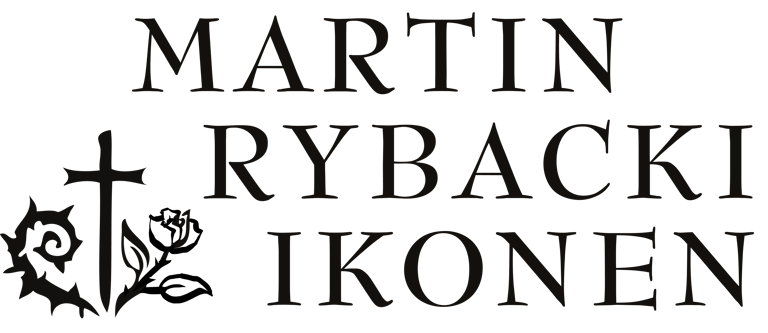Theology of the Icon - Online Talk
An online talk given for the St. Peter and St. Paul Orthodox Church in Ireland, Dublin, about the theology of the icon.
VIDEO
This is an edited and extended transcript of the online talk given for the St. Peter and St. Paul Orthodox Church in Ireland, Dublin, about the theology of the icon.
Inspired by the questions, especially by Fr. Mikhail’s question about the role of the icon in the notion of participation and communion, I formulated some of my answers here more fully and precisely.

0. Introduction
Since the topic at hand is vast my talk will try to deal with some basic ideas and is by no means exhaustive. Let's begin by looking at two words in the title:
“Icon” comes from the Greek word - (εἰκών - eikṓn) – and means simply image. For us today it is a Proper Name and means sacred image in the context of the orthodox church.
The word “theology” as we all know comes from the Greek words theos = God and logos = speech. There are three ways to understand this:
Theology is
1. talking about God = an academic discipline, and although useful actually is not theology in its true sense
2. talking with God = prayer
3. talking from God = prophecy, speaking revelation, talking from experience
The famous saying by the oriental Desert Father Evagrios Pontikos goes something like this: A true theologian is one who prays – or: one who knows how to pray. It means that a proper theologian is someone who mastered prayer – which means someone who by Grace united him- or herself with God - and now can speak about divine things - in as much as it is possible to talk about them of course – we remember St Paul in his 2nd letter to the Corinthians being: “caught up to the third heaven. And I know such a man - whether in the body or out of the body I do not know, God knows - how he was caught up into Paradise and heard inexpressible words, which it is not lawful for a man to utter.” (2 Cor 12, 2-4)
Here we already have a hint at the difficulty to express uncreated things with created means like words and images. It is actually impossible, so we use analogy and allusion, we say things by negation, this is the so called apophatic theology, saying what God is not. Images are the opposite, they are cataphatic, they show what is and not what is not, they do not negate, they affirm.
Let us look at what exactly they affirm and how they do it.
So if we talk about the theology of the icon, it follows that icons play a role in talking about, with and from God – these three are of course connected.
1. Talking about God
Icons talk about God by showing events and holy people and figures from the Old and New Testament, they do this by compressing and heightening the meaning of the historical events, leaving things out that are not central to the theological message and bringing things together in a truly symbolic way to express a deeper and more fundamental meaning that is flowing through the whole Bible narrative and the tradition of the Church.
Moses at the Burning Bush from the Old Testament
Palm Sunday from the New Testament
In the west religious images became more and more a playground for artist to explore ways of depiction. The self-expression of the artist was the driving force, the subject matter just the pretence. The religious content remained for a couple of centuries due to the patrons occupying religious offices and an overall still religious cultural narrative. When the merchant class rose to wealth they started to commission more and more secular images, providing people an outlet for their passionate appetites and so influencing them back aesthetically, cognitively, culturally and spiritually. In the east the way of depiction remained fixed because it was tied to the subject matter, it was an extension and expression of it. While in the west there was no strict right or wrong according to a grand narrative, just aesthetic pleasure or not, in the east a canonical icon could be verified by theology and the life in the church. The images in the west have been detached ontologically and spiritually from its grounding in revelation and became expressions of human self-reference. Once let loose this lead to the results we see not only in religious imagery but in western creative production as a whole.
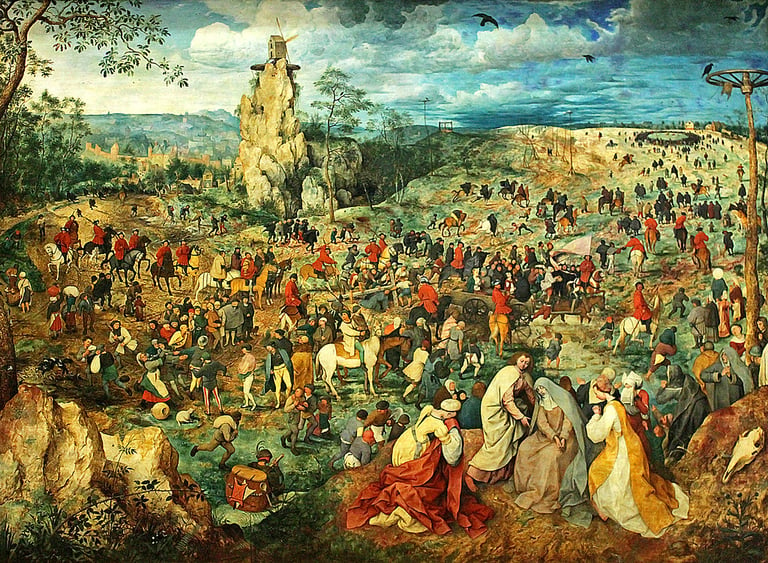

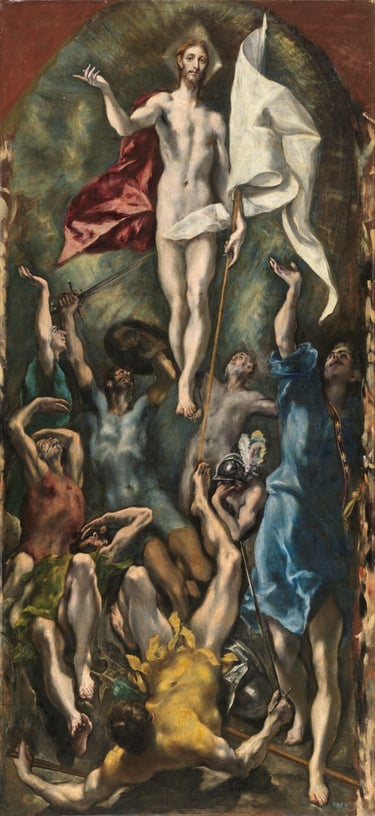

Crucifiction by Peter Bruegel and Resurrection by El Greco
2. Talking with God
We use icons to talk with God in prayer, they help us focus our attention. By what they depict they mediate between us and God. They enable us to establish a connection with the heavenly world through a liturgical and Eucharistic way of being and acting, liturgical refers to worship and Eucharistic refers to sacrifice, simply put icons “make” us worship God and make sacrifices to Him.
Sacrifice is central to the Christian life and takes many forms. When we want to possess an icon, ideally we commission an hand-painted icon and sacrifice money we worked for, the painter makes sacrifices because the work is physically and mentally demanding, everyone involved sacrifices time and the possibility to do something else. God gives his creatures the possibility to offer creation back up to him, to sacrifice itself to him as he did for it. This is however not a act of transaction but of participation, communion and transfiguration, an act of marriage. In the icon egg, chalk and pigment represent the whole of creation as products of the world of animals, plants und minerals and when they come together in the right order they are transformed through beauty into something higher than its components – the whole is more than the sum of its parts. We transform the world into something to worship God, we elevate matter for His glorification, so that matter can participate in worship. The late Metr. Kallistos Ware says that through icons the human being “can act as priest of creation offering the world back to God” as in “thy own of thy own we offer to the” referring to the Eucharist itself where God gives grain and grapes for us to transform into bread and wine through labour – which traditionally understood is true art, an act of purposefully gathering creation and beautifully transforming it for the practical and spiritual use of the community towards the highest common good that is God. Real participation and communion is something that transforms the person(s) involved, the artist and the user, the giver and the recipient – this is the core of the Liturgy. The Liturgy, the Eucharist, prayer and theology thus are a way of living, a way of living in the presence of God.
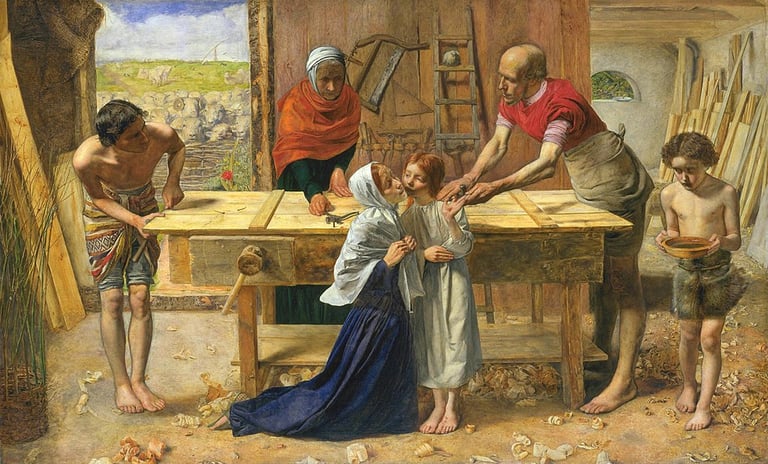

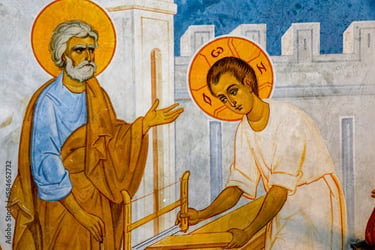

Jesus and Joseph in the workshop - Detail from a fresco in the Greek orthodox church of the Annunciation, Nazareth, Israel; and "The Carpenter's Shop" by John Everett Millais
3. Talking from God
Icons talk from God by the simple fact that they exist. The icon painter and famous orthodox scholar Leonid Uspenskij calls icons the only true Christian work of art. This sounds strange because we can see different art forms and artefacts in the church like chanting, architecture, carpentry, stone and wood carving, vestments, liturgical items, hymnography, and so on. So what does Uspenskij mean then?
Let me answer this with some rhetorical questions:
If God did not become incarnate:
- could we sing him songs and write hymns? Yes, we could.
- could we make vestments and build churches? Yes, we could.
- could we make an image of him? No, we could not.
The fact that we depict Christ is a testimony, a confession of the core beliefs of Christianity: the incarnation and - the resurrection. No incarnation, no icons.
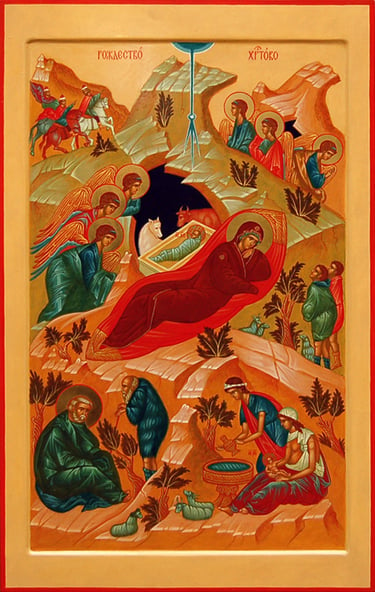

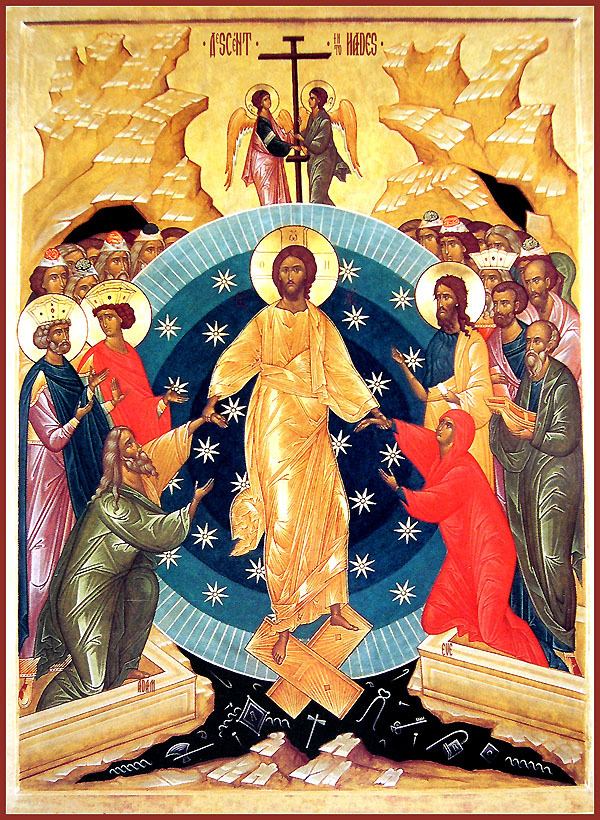

In what sense are icons a confession of the incarnation?
Obviously because God became man, “God is Spirit” (John 4, 24) so spirit became matter, we can not depict spirit but matter we can. If Christ incarnated today, we could take a photo of him.
However you may have heard of the period of Iconoclasm in the 8th and 9th century, a time where sacred images were attacked. They were attacked by Christians who had a wrong understanding of the 2nd commandment God gave to Moses on Mt Sinai, and who were also influenced by Islam. In Exodus 20 God gives Moses the Ten Commandments and the 2nd commandment says: “Thou shalt not make unto thee any graven image, or any likeness of any thing that is in heaven above, or that is in the earth beneath, or that is in the water under the earth. Thou shalt not bow down thyself to them, nor serve them.”
This is talking about idol worship, worship of nature, animals, trees, the sea and the stars, which was all prevalent at that time and a common pagan practice. Graven image means idol, it explicitly says “do not serve them” this means do not worship them, offer sacrifices to them as if they were God. The enemies of icons absolutized this commandment framing all image production as idolatry, but we can read that soon after God gives Moses the 10 Commandments He orders him to make images of Cherubim for the Tabernacle and sculptures of Cherubim for the Ark of the Covenant, later in Numbers 21 God orders him to make the Bronze Serpent on a pole for people to look at and be healed from snake bites. Btw the Jewish Temple in Jerusalem was decorated from top to bottom with images, it’s all in the Old Testament, the Jewish ban on images came with the emergence of Rabbinic Judaism around the 4th century A.D. in order to distance what was left of Judaism from Christianity.
So either God prohibits images and then violates His own prohibition or there is a difference between images as idols and religious images that God allows because they are not meant to be worshipped. We see, it is about intention and purpose.
So what we do in the Church is not worship of idols but veneration of the image of the person that is depicted in order to honour the person, as St. Basil the Great says: The honour given to the image is transferred to the prototype.
The prototype here is the incarnate Second Person of the Trinity, Jesus Christ, the Son of God. When something is depictable it means it is created, it has a created nature. However God has an uncreated nature.
Here icons show us the theological teaching about the Two Natures in Christ. There are two natures in Christ that are “not mixed, not separated, not changed and not divided”, He is fully God and fully Man. There are depictions of the God the father, they are western, Latin, and not canonical.
Now the iconoclasts attacked this point about the two natures in Christ claiming that, if the natures are not separate und not divided, and - if the divine nature can not be depicted, we actually do separate the natures when we only paint the human nature of Christ.
Well, the answer was: By painting the image of Christ we do not separate the divine nature from the human nature because we do not paint natures as such but a person who has two natures. Natures can not be separated from their particular instantiations, we can not paint the nature of a dog, or a car, or a child, what we paint is the particular expression of that nature in the dog, in the car or in the child.
So, the icon teaches us theology just by being what it is.
Speaking of the human nature of Christ depicted in the icon we come to the second confession the icon makes, the confession of the resurrection.
In what sense are icons a confession of the resurrection?
They confess the resurrection because they show Christ in his deified nature after the incarnation, even more, they show him during His second coming – we can see this in the pantocrator icon in the dome of the church. As mentioned above, these are attempts to depict things of which we do not have full knowledge, but which the Church deemed proper through prayer and discernment for this our earthly life until we will see fully.
When we look at the iconostasis, we see the royal doors in the middle, flanked by the icon of the Mother of God with the Christ Child on the left, and Christ on the right. The icon of the mother of God is the icon of the incarnation, the Holy Virgin holding God who became flesh out of her flesh and blood, on the left the icon of Christ is the icon of the resurrection, the risen Christ now deified victorious over death. What happens between the two icons behind the royal doors on the alter is the salvation work of Christ, His sacrifice that we read about in the Gospel. He offers himself to us so that we might be healed and united to Him and live.
St. Athanasius of Alexandria says, “God became Man so that Man might become God” speaking of theosis, of deification, so what we partake of in the Eucharist is the deified flesh and blood of the risen Christ: “Whoever eats My flesh and drinks My blood has eternal life, and I will raise him up at the last day” (John 6, 54), Christ connects communion with resurrection, the Priest prays the Resurrection hymn after he served communion “Having beheld the resurrection of Christ, let us worship the Lord Jesus…”.
We as modern people do not connect these things naturally, we have to learn them. People living in the church and in prayer and with the gospel had an natural intuition for these things and composed the icons and the churches and the songs in the way they did in order to express God’s revelation.
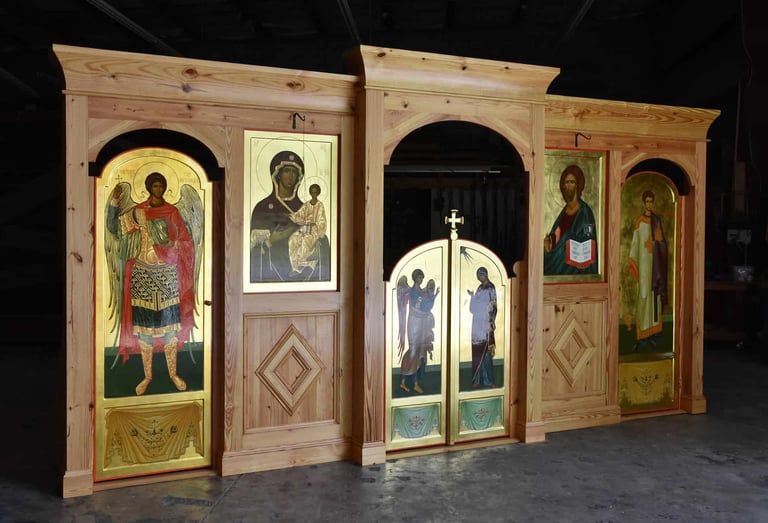

Woodwork by Andrew Gould
4. Energies and the Halo
Up until now we have dealt with the theological teaching of the nature-person-distinction and we have heard the word theosis. What makes theosis possible is tied to icons as well.
St. Gregory Palamas was one of the prominent Saints to talk about the specifics in the workings of God from which came forth the teaching of the so called essence-energy-distinction. For human rationality it seems logical that we can not reach and experience God because we are created and he is uncreated, because by definition the uncreated is not in the domain of the created and vice versa.
This way of thinking leads to the idea that the Light in which Christ showed himself on Mount Tabor to Peter, James and John during his Transfiguration is indeed created. This is unfortunately the western Latin position. St. Gregory and the Orthodox Church state that this light is uncreated, it means that it is God himself acting in creation with his uncreated energies, it tells us that the mode in which God operates towards creation is itself uncreated therefore divine – however it is not his essence, his essence remains unknowable to us created beings, his energies however which are divine we can participate in.
St. Gregory talked from experience, just like St. Symeon the New Theologian, who was immersed in the uncreated light almost every time he was praying, we can see that some icons stress this by giving the saint the same Mandorla which Christ has in the transfiguration icon. So theosis is possible because God himself touches the human person and by grace lets him or her participate in divinity. That’s why icons are supposed to show the Saints transfigured, healed, deified, without infirmities and human weaknesses like overly emotional expressions, or illnesses and handicaps that were characteristic during their life-time – but the saints still are recognisable as the people they were and still are, and not as un-personal puppet like figure. Christ is shown with his wounds only in the scenes that are relevant for the message, otherwise he is represented with the healed human nature.
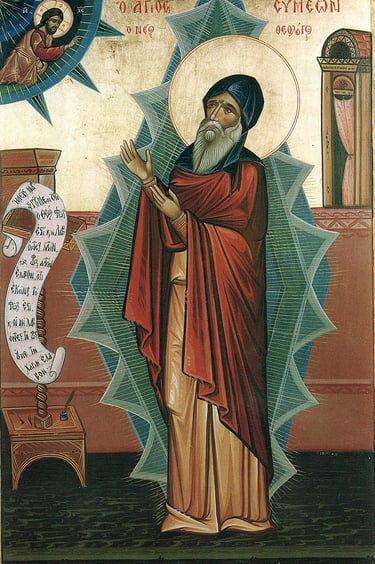

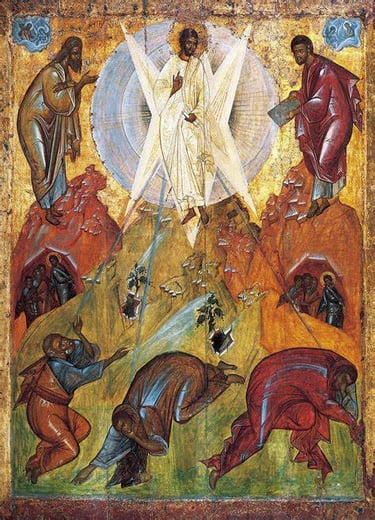

The uncreated light of God is also represented by the nimbus, or halo, the circle around Christs or the saints head.
Before the emergence of the halo as a fully theological pictorial form, it was common to paint a circle around a figure that was important for the story, even villains. Christian artist took the circle and established it over the centuries as a proper Christian theological element, especially the Halo of Christ with the Ὁ ὬΝ - “the being one” - inside of it that came up around the 11th and 12th century. There are attempts to attack the icon by pointing this out, so do not be impressed. The halo had a different meaning or it was pagan, that’s true, but now it isn’t, and hasn’t been for almost 2000 years. Say thank you and move on.
So if the Halo is the light of God in which the Saints participated and by which they were deified, and if Christ is God, then every icon becomes an icon of Christ, because it is the light and energy of Christ that is shining out of the Saints, like St. Paul says “it is no longer I who live, but Christ lives in me” (Gal 2, 20).
If we compare the halo of the eastern icon to the depictions in the Latin religious images we can see the consequence of theological differences. Where in the east the halo generally remains a circle because geometrical forms are the closet to depict things of the spirit and of the mind, aka. metaphysics, in the west the halo becomes either an actual physical light source or a plate or a ring, which drags the uncreated into the concrete created. Which has grave implications for what happens in the Eucharist…
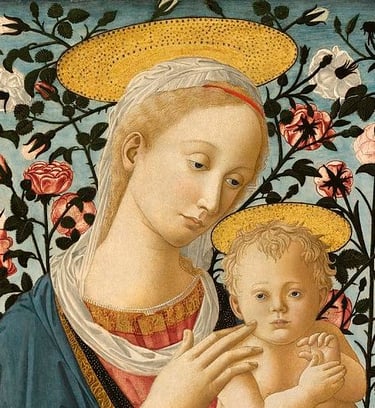

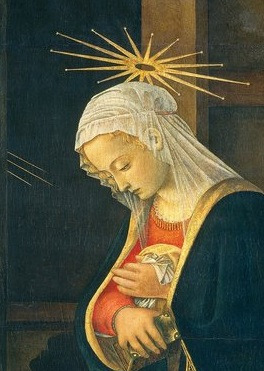

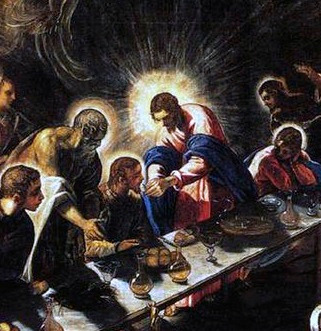





Paintings by Lippi, Boticelli, Montagna and Goitto
5. Images express world views
So now we have seen how icons express some of the many important theological concepts.
Now let us look on some of the icon’s stylistic and concrete pictorial aspects and what role they play in the icon’s function as objects of prayer.
Icons are associated with silence, as if they spoke from a world of silence to the inner turmoil in the soul of man, calming it when man is willing to turn inwards. Especially to our modern sensebilities how the icon is made speaks of a more spiritual way of being. This is achieved pictorially by a tilt towards abstraction, since abstraction is related to thought and naturalism to sense percception. Calmness is achieved through toning down movement, order is emphesised by reduction in perspective and less overlays of elements. These are pictorial principles that reflect spiritual realities and qualify the world view that birthed the icon.
From my experience people tend to ask about the theological meaning of colours, I can understand that, but that is actually not relevant to the core theological truths the icon expresses. Whether blue means this or red means that is not the most important thing, it is rather remaining on the surface, there are certain notions about colour that do have spiritual origin (you can look to St. Dionysius the Aeropagite), but they are just as well aesthetical choices that have taken root and been handed down, because it simply looks commonly beautiful due to our human disposition, beauty is a tricky subject though and reveals maybe most clearly the fallen nature of man, because we tend to confuse beauty with sensual pleasure. The mystery is somewhere else, in the Person of Christ, not in the material or sensual experience.
Let us again compare the icon to the Latin image regarding the depiction of the figures. We briefly touched upon this before.
One fundamental part of orthodox teaching and life is ascesis, the fight against the passions. Through the purification of the heart from the passions, through the illumination of the Nous, one reaches deification of his or her whole person. In this process soberness, Nepsis, and focus of mind are acquired which then lead to stillness, Hesychia. He can see this depicted in the calmness, soberness, simplicity, lack of movement and exaggerated poses and emotions, the backgrounds are muted, the colours tend to be natural and not flashy, things that are not important are left out, the focus is on the figures which do not try to impress us with their bodily appearance or activity. Now in the west we have a lot of movement, emphasis on the body, emotions, even nakedness and an overly erotic tone. This is actually the polar opposite to icons, here passions rules, there is not fasting, no prayer of the heart. One famous contemporary iconographer said, an I agree with him, that the moment the west has began to use concrete human models for the face of Christ, it lost the icon. Orthodoxy has kept it, but let us not congratulate ourselves, with the truth comes great responsibility.
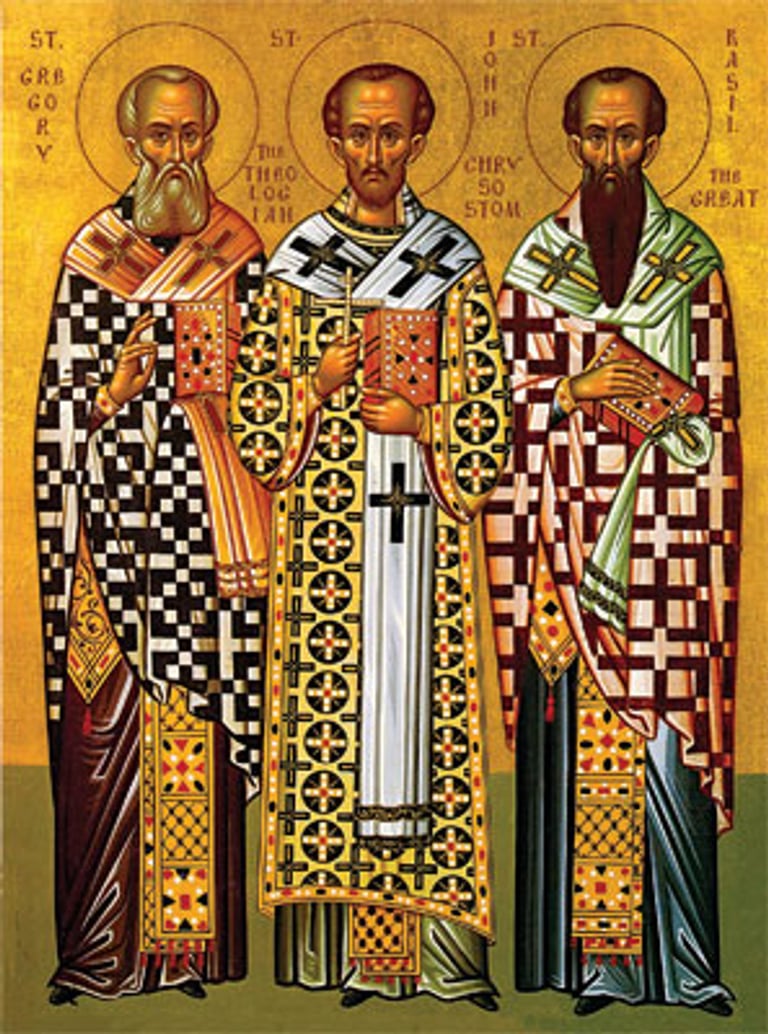

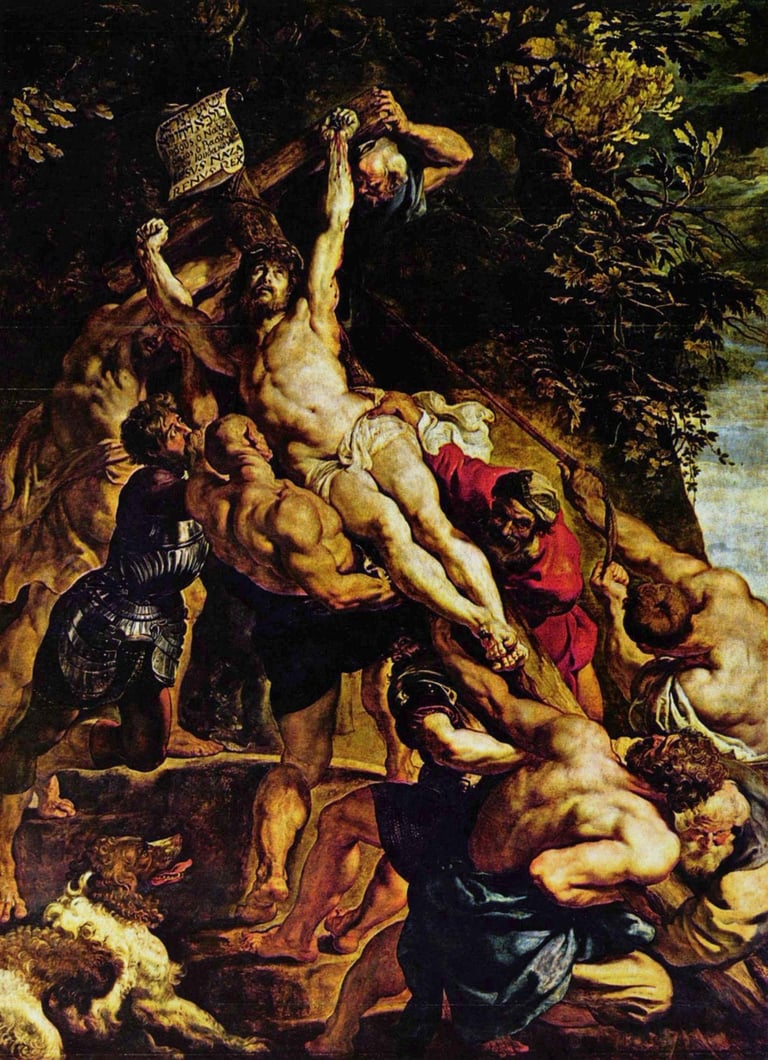

So when we stand in prayer in front of our Holy Icons, let us try to be aware that they are made that way for a very specific reason, they invite us to become like the persons that are painted on them, everyone of us has an icon of Christ at the bottom and the centre of their soul, but it is covered with a lot of trash and illnesses, Christ came and restored the image through his incarnation, resurrection and ascension, now he calls us to clean it from the dirt of our sins and to acquire his likeness with his help as St. Peter quotes Leviticus 11, 44 where God speaks and says “you shall be holy, for I am holy”, which is in fact true theology.
Christ is risen.
Icon of the Three Holy Hierarchs and a painting by Paul Peter Rubens
